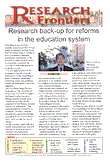 |
Concentrations of radon are about 50 per cent higher in Hong Kong buildings compared to the global average. The gas is said to cause lung cancer. The biggest source of radon in buildings is granite used in concrete, says Dr Peter K N Yu from CityU.
His research at CityU, already completed, focused on the use of lightweight concretes which do not contain granite, and high strength concrete containing silica fume, a material which significantly reduces radon emissions.
At HKU, in a project under Dr M Y W Tso, a radon exposure room has been set up to study the generation of radon and its transportation into room air under changing conditions. Radon exposure levels on occupants was researched, and a technique was developed to extract radon generated in concrete slabs so as to reduce indoor radon levels.
Principal Investigators > Dr
Peter K N Yu > Email > peter.yu@cityu.edu.hk
Dr M Y W Tso > Email > mmytso@hkucc.hku.hk
Dr M Y W Tso > Email > mmytso@hkucc.hku.hk